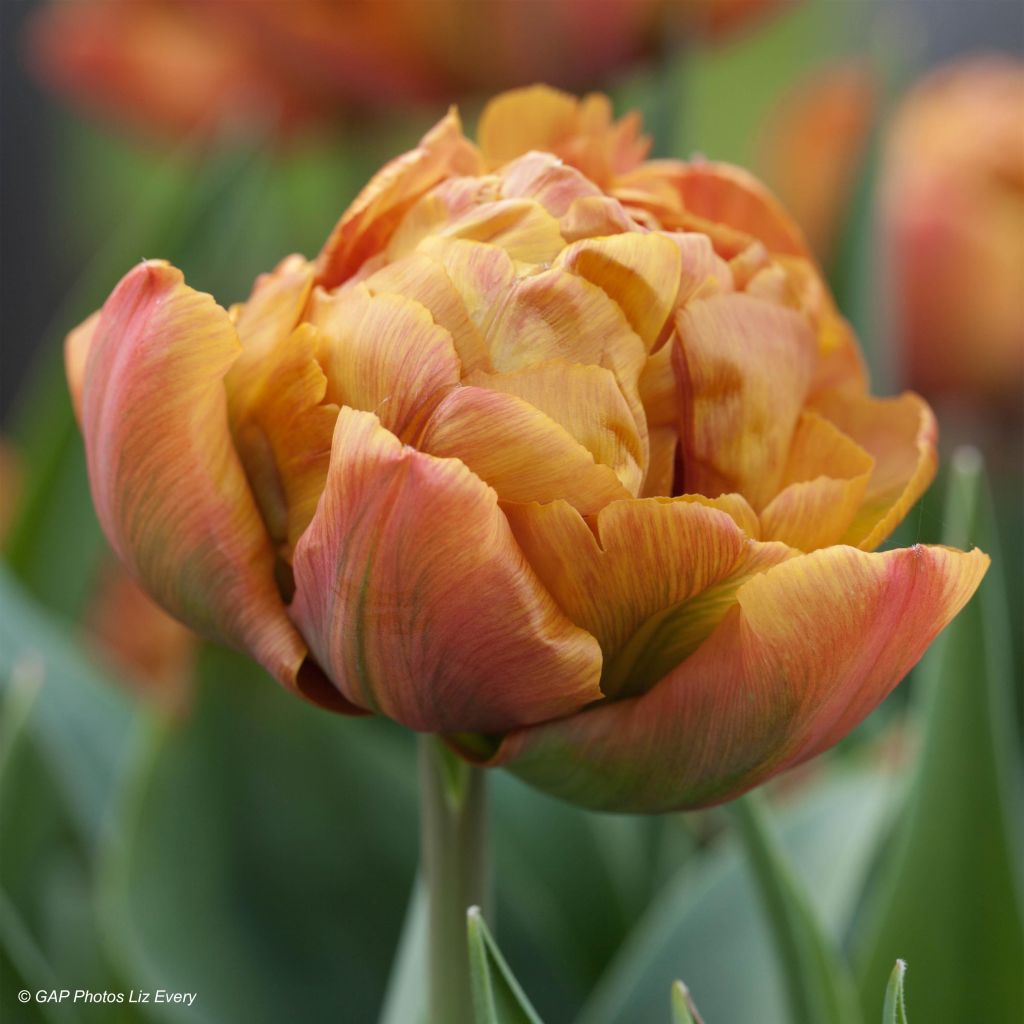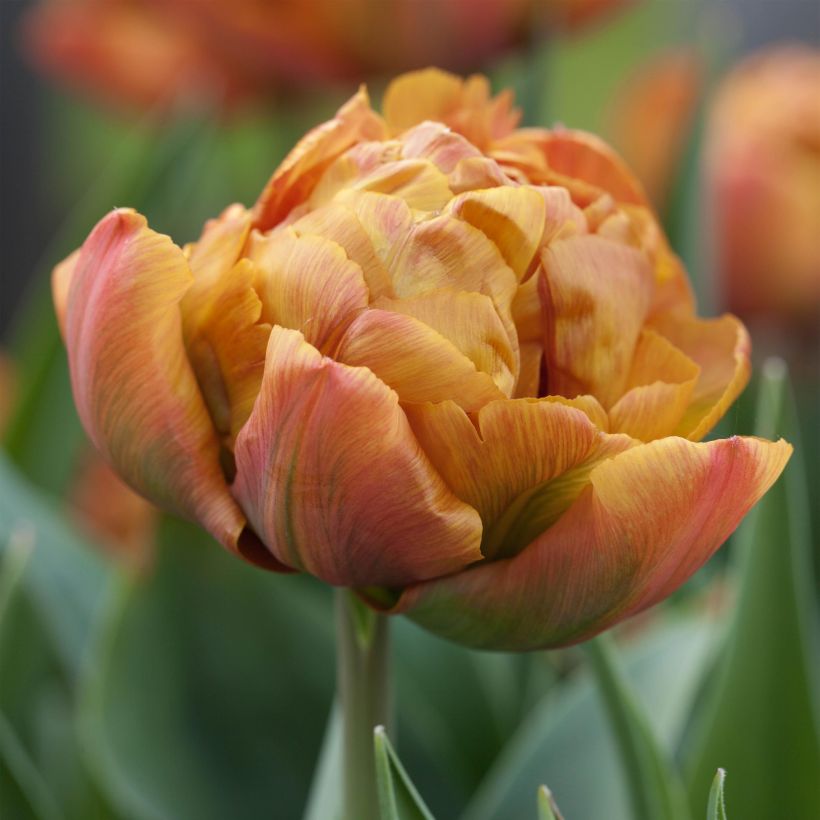

Tulipa Brownie- Double Early Tulip
Tulipa Brownie- Double Early Tulip
Tulipa Brownie
Early double Tulip
Very fast delivery and arrived in good condition and well packaged. Bulbs of good diameter and nice appearance." Analysis: The translation accurately conveys the meaning and context of the original text. The tone remains the same throughout the translation. There are no spelling or grammar errors, and the sentence structure is correct. The idiomatic expressions and nuances of the original text are preserved in the translation.
Brielles B., 19/11/2018
This plant carries a 6 months recovery warranty
More information
We guarantee the quality of our plants for a full growing cycle, and will replace at our expense any plant that fails to recover under normal climatic and planting conditions.
From €5.90 for pickup delivery and €6.90 for home delivery
Express home delivery from €8.90.
Does this plant fit my garden?
Set up your Plantfit profile →
Description
The Double Early Tulip, Tulipa 'Brownie' is a recently discovered variety that is delightful for the eyes and the nose. The double flower of this variety has a delicious and spicy colour, made of a blend of coppery or bronze orange, caramel and cocoa, enhanced by a touch of buttery yellow and vanilla. It opens up into a large, well-formed cup, and then unfolds like a peony with multiple petals. This beautiful flower is also fragrant. It is perched at the end of a short stem that is resistant to bad weather and emerges from broad blue-green foliage. It flowers after early single tulips.
The 'Brownie' Tulip, introduced in 2015, belongs to the Lily family. Originally horticultural, it is currently classified in the group of double early tulips, whose main characteristic is that they all flower at the same height, making them a popular choice for well-regulated flowerbeds. They are often available in a mix of colours under the name 'Murillo' tulips. Perched on strong 35 cm (14in) stems just above the broadly lanceolate leaves, the double flowers open almost flat and are 12 cm (5in) wide at full bloom, in a symphony of very warm tones rarely seen in tulips. They flower in April, in the heart of the tulip season.
Double early tulips with peony flowers are very popular with their rich colours and sturdy and resistant flowers, suitable for flowerbeds and bouquets. It is no coincidence that they are among the most commonly used varieties for cut flowers and are unmatched for bringing the colours of spring to pots or sunny gardens. Remember to consider the height and flowering period of tulips when designing your flowerbeds, as these can vary significantly from one cultivar to another. It is a good idea to plant a few more bulbs for beautiful long-lasting cut flowers. 'Brownie', with its very warm colour, pairs beautifully with the blue flowers of grape hyacinths or wood hyacinths.
Report an error about the product description
Tulipa Brownie- Double Early Tulip in pictures


Plant habit
Flowering
Foliage
Botanical data
Tulipa
Brownie
Liliaceae
Early double Tulip
Cultivar or hybrid
Planting and care
Plant the bulbs in autumn, from September to December, at a depth of 15 cm (6in), 10 cm (4in) apart in regular, slightly acidic, neutral, or slightly alkaline, loose, well-worked, and well-draining soil. Never add manure or poorly decomposed compost to the planting soil, as this could cause the bulbs to rot. Brownie will thrive in moist to dry soil. Plant it in a suitable location, either sunny or partially shaded. Once flowering is over, it is best to remove the seed heads to avoid exhausting the plant.
Planting period
Intended location
Care
-
, onOrder confirmed
Reply from on Promesse de fleurs
Haven't found what you were looking for?
Hardiness is the lowest winter temperature a plant can endure without suffering serious damage or even dying. However, hardiness is affected by location (a sheltered area, such as a patio), protection (winter cover) and soil type (hardiness is improved by well-drained soil).

Photo Sharing Terms & Conditions
In order to encourage gardeners to interact and share their experiences, Promesse de fleurs offers various media enabling content to be uploaded onto its Site - in particular via the ‘Photo sharing’ module.
The User agrees to refrain from:
- Posting any content that is illegal, prejudicial, insulting, racist, inciteful to hatred, revisionist, contrary to public decency, that infringes on privacy or on the privacy rights of third parties, in particular the publicity rights of persons and goods, intellectual property rights, or the right to privacy.
- Submitting content on behalf of a third party;
- Impersonate the identity of a third party and/or publish any personal information about a third party;
In general, the User undertakes to refrain from any unethical behaviour.
All Content (in particular text, comments, files, images, photos, videos, creative works, etc.), which may be subject to property or intellectual property rights, image or other private rights, shall remain the property of the User, subject to the limited rights granted by the terms of the licence granted by Promesse de fleurs as stated below. Users are at liberty to publish or not to publish such Content on the Site, notably via the ‘Photo Sharing’ facility, and accept that this Content shall be made public and freely accessible, notably on the Internet.
Users further acknowledge, undertake to have ,and guarantee that they hold all necessary rights and permissions to publish such material on the Site, in particular with regard to the legislation in force pertaining to any privacy, property, intellectual property, image, or contractual rights, or rights of any other nature. By publishing such Content on the Site, Users acknowledge accepting full liability as publishers of the Content within the meaning of the law, and grant Promesse de fleurs, free of charge, an inclusive, worldwide licence for the said Content for the entire duration of its publication, including all reproduction, representation, up/downloading, displaying, performing, transmission, and storage rights.
Users also grant permission for their name to be linked to the Content and accept that this link may not always be made available.
By engaging in posting material, Users consent to their Content becoming automatically accessible on the Internet, in particular on other sites and/or blogs and/or web pages of the Promesse de fleurs site, including in particular social pages and the Promesse de fleurs catalogue.
Users may secure the removal of entrusted content free of charge by issuing a simple request via our contact form.
The flowering period indicated on our website applies to countries and regions located in USDA zone 8 (France, the United Kingdom, Ireland, the Netherlands, etc.)
It will vary according to where you live:
- In zones 9 to 10 (Italy, Spain, Greece, etc.), flowering will occur about 2 to 4 weeks earlier.
- In zones 6 to 7 (Germany, Poland, Slovenia, and lower mountainous regions), flowering will be delayed by 2 to 3 weeks.
- In zone 5 (Central Europe, Scandinavia), blooming will be delayed by 3 to 5 weeks.
In temperate climates, pruning of spring-flowering shrubs (forsythia, spireas, etc.) should be done just after flowering.
Pruning of summer-flowering shrubs (Indian Lilac, Perovskia, etc.) can be done in winter or spring.
In cold regions as well as with frost-sensitive plants, avoid pruning too early when severe frosts may still occur.
The planting period indicated on our website applies to countries and regions located in USDA zone 8 (France, United Kingdom, Ireland, Netherlands).
It will vary according to where you live:
- In Mediterranean zones (Marseille, Madrid, Milan, etc.), autumn and winter are the best planting periods.
- In continental zones (Strasbourg, Munich, Vienna, etc.), delay planting by 2 to 3 weeks in spring and bring it forward by 2 to 4 weeks in autumn.
- In mountainous regions (the Alps, Pyrenees, Carpathians, etc.), it is best to plant in late spring (May-June) or late summer (August-September).
The harvesting period indicated on our website applies to countries and regions in USDA zone 8 (France, England, Ireland, the Netherlands).
In colder areas (Scandinavia, Poland, Austria...) fruit and vegetable harvests are likely to be delayed by 3-4 weeks.
In warmer areas (Italy, Spain, Greece, etc.), harvesting will probably take place earlier, depending on weather conditions.
The sowing periods indicated on our website apply to countries and regions within USDA Zone 8 (France, UK, Ireland, Netherlands).
In colder areas (Scandinavia, Poland, Austria...), delay any outdoor sowing by 3-4 weeks, or sow under glass.
In warmer climes (Italy, Spain, Greece, etc.), bring outdoor sowing forward by a few weeks.


































